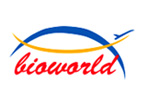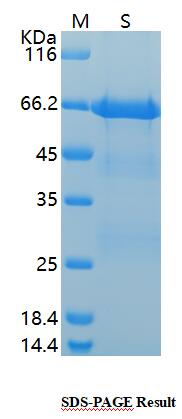Product Name :
CD114/CSF3R Recombinant Protein Swiss-Prot :
Q99062 Host :
E.coli Tag :
≥0.5mg/ml Amino acid Sequence :
ECGHISVSAPIVHLGDPITASCIIKQNCSHLDPEPQILWRLGAELQPGGRQQRLSDGTQESIITLPHLNHTQAFLSCCLNWGNSLQILDQVELRAGYPPAIPHNLSCLMNLTTSSLICQWEPGPETHLPTSFTLKSFKSRGNCQTQGDSILDCVPKDGQSHCCIPRKHLLLYQNMGIWVQAENALGTSMSPQLCLDPMDVVKLEPPMLRTMDPSPEAAPPQAGCLQLCWEPWQPGLHINQKCELRHKPQRGEASWALVGPLPLEALQYELCGLLPATAYTLQIRCIRWPLPGHWSDWSPSLELRTTERAPTVRLDTWWRQRQLDPRTVQLFWKPVPLEEDSGRIQGYVVSWRPSGQAGAILPLCNTTELSCTFHLPSEAQEVALVAYNSAGTSRPTPVVFSESRGPALTRLHAMARDPHSLWVGWEPPNPWPQGYVIEWGLGPPSASNSNKTWRMEQNGRATGFLLKENIRPFQLYEIIVTPLYQDTMGPSQHVYAYSQEMAPSHAPELHLKHIGKTWAQLEWVPEPPELGKSPLTHYTIFWTNAQNQSFSAILNASSRGFVLHGLEPASLYHIHLMAASQAGATNSTVLTLMTLTPEGSELH Restriction sites :
NdeI-XhoI Background :
The diverse biological activities of G-CSF are initiated by the binding of G-CSF to a specific receptor (G-CSFR) that belongs to the cytokine/hematopoietic receptor superfamily. In contrast to the majority of hematopoietic receptors that are activated through the formation of heteromeric complexes composed of α, β and sometimes γ subunits, G-CSFR proteins are believed to form homodimeric complexes upon ligand binding. Four distinct alternative splice variants of G-CSFR have been described, one of which exists as a soluble receptor protein. Although G-CSFR lacks consensus motifs in its cytoplasmic domains that are characteristic of kinase activities, certain sequences have been identified that are conserved among several members of the cytokine receptor superfamily. For example, the carboxy terminal regions of G-CSFR contain a domain, designated box 3, that is only shared with the IL-6R subunit, gp130. Soluble :
PBS, 4M Urea, PH7.4 Purification&Purity :
Transferred into competent cells and the supernatant was purified by NI column affinity chromatography and the purity is > 85% (by SDS-PAGE). Storage&Stability :
Store at 4°C short term. Aliquot and store at -20°C long term. Avoid freeze-thaw cycles. Expression vector :
pet-22b(+) BiowMW :
~66kDa Note :
For research use only, not for use in diagnostic procedure. concentration :
≥0.5mg/ml
CD114/CSF3R Recombinant Protein Swiss-Prot :
Q99062 Host :
E.coli Tag :
≥0.5mg/ml Amino acid Sequence :
ECGHISVSAPIVHLGDPITASCIIKQNCSHLDPEPQILWRLGAELQPGGRQQRLSDGTQESIITLPHLNHTQAFLSCCLNWGNSLQILDQVELRAGYPPAIPHNLSCLMNLTTSSLICQWEPGPETHLPTSFTLKSFKSRGNCQTQGDSILDCVPKDGQSHCCIPRKHLLLYQNMGIWVQAENALGTSMSPQLCLDPMDVVKLEPPMLRTMDPSPEAAPPQAGCLQLCWEPWQPGLHINQKCELRHKPQRGEASWALVGPLPLEALQYELCGLLPATAYTLQIRCIRWPLPGHWSDWSPSLELRTTERAPTVRLDTWWRQRQLDPRTVQLFWKPVPLEEDSGRIQGYVVSWRPSGQAGAILPLCNTTELSCTFHLPSEAQEVALVAYNSAGTSRPTPVVFSESRGPALTRLHAMARDPHSLWVGWEPPNPWPQGYVIEWGLGPPSASNSNKTWRMEQNGRATGFLLKENIRPFQLYEIIVTPLYQDTMGPSQHVYAYSQEMAPSHAPELHLKHIGKTWAQLEWVPEPPELGKSPLTHYTIFWTNAQNQSFSAILNASSRGFVLHGLEPASLYHIHLMAASQAGATNSTVLTLMTLTPEGSELH Restriction sites :
NdeI-XhoI Background :
The diverse biological activities of G-CSF are initiated by the binding of G-CSF to a specific receptor (G-CSFR) that belongs to the cytokine/hematopoietic receptor superfamily. In contrast to the majority of hematopoietic receptors that are activated through the formation of heteromeric complexes composed of α, β and sometimes γ subunits, G-CSFR proteins are believed to form homodimeric complexes upon ligand binding. Four distinct alternative splice variants of G-CSFR have been described, one of which exists as a soluble receptor protein. Although G-CSFR lacks consensus motifs in its cytoplasmic domains that are characteristic of kinase activities, certain sequences have been identified that are conserved among several members of the cytokine receptor superfamily. For example, the carboxy terminal regions of G-CSFR contain a domain, designated box 3, that is only shared with the IL-6R subunit, gp130. Soluble :
PBS, 4M Urea, PH7.4 Purification&Purity :
Transferred into competent cells and the supernatant was purified by NI column affinity chromatography and the purity is > 85% (by SDS-PAGE). Storage&Stability :
Store at 4°C short term. Aliquot and store at -20°C long term. Avoid freeze-thaw cycles. Expression vector :
pet-22b(+) BiowMW :
~66kDa Note :
For research use only, not for use in diagnostic procedure. concentration :
≥0.5mg/ml
Blocking peptide available as NCP0250P

 CD114/CSF3R Recombinant Protein
CD114/CSF3R Recombinant Protein 
 Datasheet
Datasheet COA
COA MSDS
MSDS SHIP
SHIP